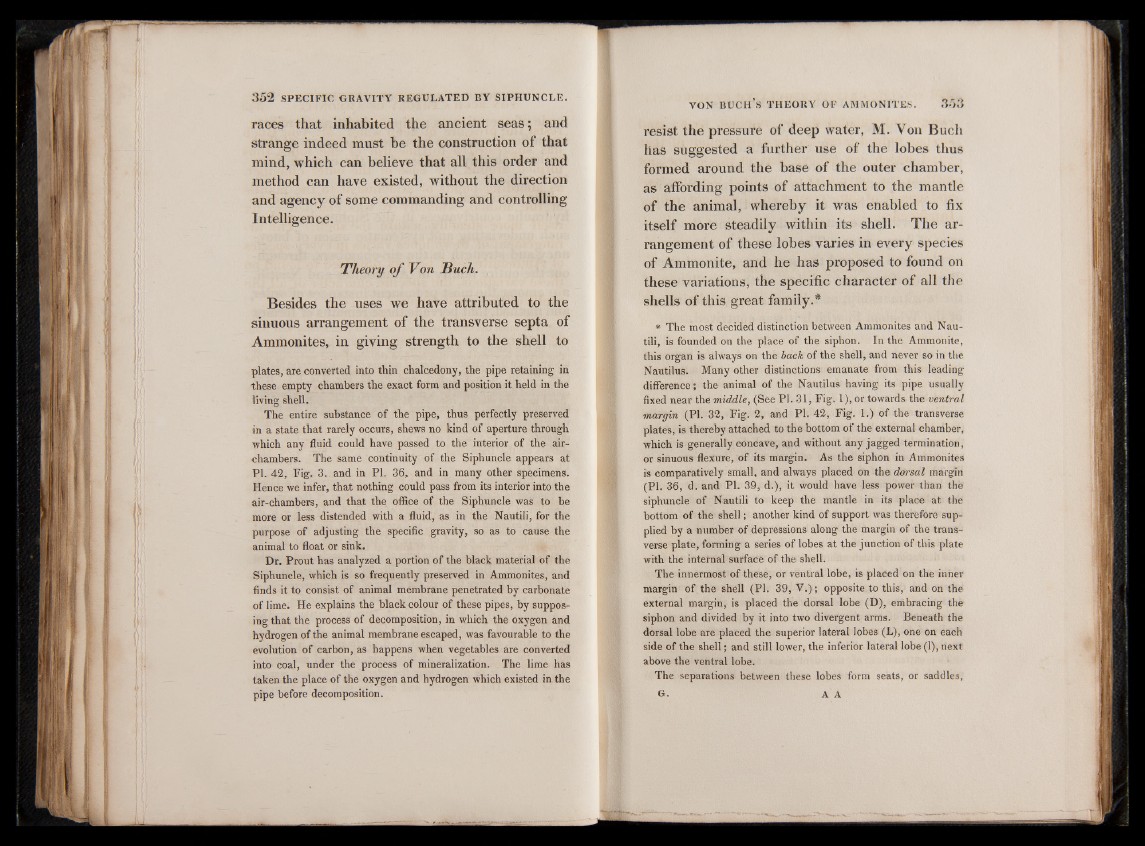
races that inhabited the ancient seas ; and
strange indeed must be the construction of that
mind, which can believe that all this order and
method can have existed, without the direction
and agency of some commanding and controlling
Intelligence.
Theory o f Von Buck.
Besides the uses we have attributed to the
sinuous arrangement of the transverse septa of
Ammonites, in giving strength to the shell to
plates, are converted into thin chalcedony, the pipe retaining in
these empty chambers the exact form and position it held in the
living shell.
The entire substance of the pipe, thus perfectly preserved
in a state that rarely occurs, shews no kind of aperture through
which any fluid could have passed to the interior of the air-
chambers. The same continuity of the Siphuncle appears at
PI. 42, Fig. 3. and in PI. 36, and in many other specimens.
Hence we infer, that nothing could pass from its interior into the
air-chambers, and that the office of the Siphuncle was to be
more or less distended with a fluid, as in the Nautili, for the
purpose of adjusting the specific gravity, so as to cause the
animal to float or sink.
Dr. Prout has analyzed a portion of the black material of the
Siphuncle, which is so frequently preserved in Ammonites, and
finds it to consist of animal membrane penetrated by carbonate
of lime. He explains the black colour of these pipes, by supposing
that the process of decomposition, in which the oxygen and
hydrogen of the animal membrane escaped, was favourable to the
evolution of carbon, as happens when vegetables are converted
into coal, under the process of mineralization. The lime has
taken the place of the oxygen and hydrogen which existed in the
pipe before decomposition.
resist the pressure of deep water, M. Yon Buch
has suggested a further use of the lobes thus
formed around the base of the outer chamber,
as affording points of attachment to the mantle
of the animal, whereby it was enabled to fix
itself more steadily within its shell. The arrangement
of these lobes varies in every species
of Ammonite, and he has proposed to found on
these variations, the specific character of all the
shells of this great family.*
* The most decided distinction between Ammonites and Nautili,
is founded on the place of the siphon. In the Ammonite,
this organ is always on the back of the shell, and never so in the
Nautilus. Many other distinctions emanate from this leading-
difference; the animal of the Nautilus having its pipe usually
fixed near the middle, (See PI. 31, Fig. 1), or towards the ventral
margin (PI. 32, Fig. 2, and PI. 42, Fig. 1.) of the transverse
plates, is thereby attached to the bottom of the external chamber,
which is generally concave, and without any jagged termination,
or sinuous flexure, of its margin. As the siphon in Ammonites
is comparatively small, and always placed on the dorsal margin
(PI. 36, d. and PI. 39, d.), it would have less power than the
siphuncle of Nautili to keep the mantle in its place at the
bottom of the shell; another kind of support was therefore supplied
by a number of depressions along the margin of the transverse
plate, forming a series of lobes at the junction of this plate
with the internal surface of the shell.
The innermost of these, or ventral lobe, is placed on the inner
margin of the shell (PI. 39, V.); opposite to this, and on the
external margin, is placed the dorsal lobe (D), embracing the
siphon and divided by it into two divergent arms. Beneath the
dorsal lobe are placed the superior lateral lobes (L), one on each
side of the shell; and still lower, the inferior lateral lobe(l), next
above the ventral lobe.
The separations between these lobes form seats, or saddles,
G. A A